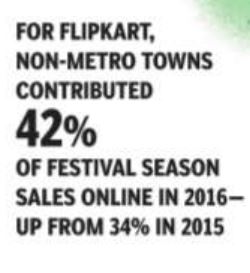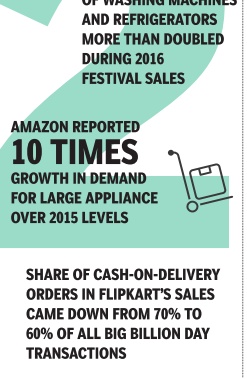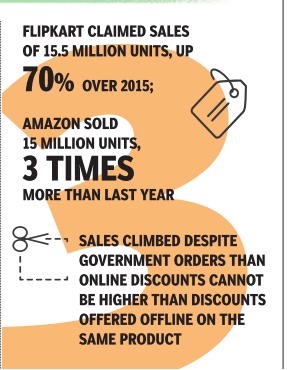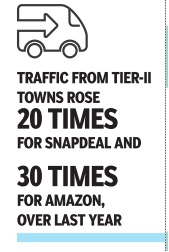E-commerce, M-commerce: India
This is a collection of articles archived for the excellence of their content. |
Contents |
History/ evolution on online shopping
2014-16: change in three major trends

Samidha Sharma, How India's e-shopping has changed, Oct 09 2016 : The Times of India
THREE TRENDS THAT SHOW HOW - INDIA'S E-SHOPPING HAS CHANGED
This festival season is seeing the rise of a new breed of e-shopper who's as cool about shopping for a smart TV as for dal and detergent
Two years ago in 2014 when Flipkart, the country's largest web retailer kicked off its first flagship Big Billion Day sale, things didn't quite go as per plan. The e-tailer wasn't able to handle the unprecedented traffic and its founders were left apologising to disgruntled shoppers for the snafus. A lot has changed since then, not only for Flipkart and for all e-commerce players, but also in the way India shops online.
Beyond the intense fight for capturing market share emblematic of the e-commerce sector, which reaches fever pitch this time of the year, what's starting to emerge is a breed of seasoned shoppers who is as comfortable shopping for an expensive smart TV as ordering their dal-detergent online.
Small-Town India Becomes Big Online
If we were to believe data from companies, online retail's march into smaller Indian cities seemed to have finally made progress this year after many attempts to amp up business from these towns. What'll be interesting to watch is if these numbers sustain. Amit Agarwal, country head of Amazon India, says among the 15 million units it sold during its `Great Indian Festival', orders came from 90% of India's pin codes. The number of new customers increased five-fold over last Diwali with 70% of new shoppers coming from tier II and tier III towns, he adds. Overall, 65% of Amazon's orders come from towns categorized as tier II (population of one million) and below. Rival Flipkart says sales from tier II and below cities went up to 42% from 34% in the past one year.
Even as e-tailers tout their strides beyond the big cities, estimates say the number of online buyers remained at around 68 million in 2016 and majority of them came from metros. “It's true that a big chunk of new customers are from tier II and tier III but their ticket sizes and frequency of purchases will take some time to increase as most of them are only shopping because of discounts,“ says Satish Meena, forecast analyst at Forrester Research.
A good part of the sales during the festive season typically comes from incremental wallet share of existing buyers. The market expansion due to new shoppers is still limited, he says.
But not for want of trying. To boost the e-tailing market which has stuttered in the past year, having remained at $10 billion in size after galloping at 400% growth the previous year, companies brought in attractive EMI and exchange schemes on electronics and white goods. Membership programmes like Amazon Prime were aimed at locking in customers on to online platforms.
Flipkart's co-founder & CEO Binny Bansal says the average order size is up 20% despite discounts compared to regular days. The e-tailer says it also brought in 1.5 million new customers this year versus one million that came on board last year even as cash-on-delivery (COD) orders came down from 70% to 60% of all Big Billion Day transactions.The decline in COD shows that more Indians now trust online platforms to deliver the goods.
Size And Price No Bar For Buyers
Mobile phones still account for a huge chunk of sales but there's been a palpable focus on high-ticket categories like white goods and large appliances. Devita Saraf, CEO of Vu Television, a brand which sells more than 60% of its products online at an average price point of Rs 25,000, says there's an emergence of a new kind of customer who is online-first in their shopping behaviour. She says her brand was among the top sellers on Flipkart during the five-day sale.
Amazon was seen pushing daily consumables heavily, a first during the sale season which is defined by deals on mobiles and electronics. During the five-day sale consumers were looking for deals on everyday use products like detergents, diapers, grocery and household products indicating that they did not forget their everyday purchases while shopping for other deals, the company says.
Less Discounting, More Sales?
Post March this year, most e-tailers reduced promotional campaigns after the Indian government introduced new policy guidelines which outlawed online marketplaces from offering discounts directly. While companies did eventually find ways to get around the re gulation, this year's sales haven't offered the kind of deep discounting as previous years. But despite that, volumes are up. Consumers are getting used to buying online more with over 20-25% of users now making a purchase once in two months, says Sahil Barua, co-founder and CEO of e-commerce logistics startup Delhivery .
Radhika Aggarwal, co-founder and CBO, ShopClues, sees this as a sign of the Indian ecommerce market maturing. “E-commerce was built on discounts to change consumer behaviour as there were no other hooks at the time.But now people wait for the sales because of the kind of selection of products they find online,“ she says. What happens post the sale-month spike will be decisive in understanding if the overall market has grown spawning new buyers or the growth was just seasonal.
Background/ profile of online shoppers
70% of new customers from tier II & III towns/ 2016
70% of new customers from tier II & III towns, says Amazon, Oct 03 2016 : The Times of India
After a year of tepid online retail sales, etailers like Flipkart, Amazon and Snapdeal witnessed a wave of consumers flocking to their platforms as the much-publicised annual festive season sale kicked off over the weekend.
Interestingly, a significant chunk of the new online shoppers is reported to have come from smaller towns in states like Sikkim, Tripura and the Andaman and Nicobar Islands. These towns are a potentially huge market that online retailers are eyeing to expand the overall ecommerce pie, which has largely failed to grow over the past year. For the Seattle-based Amazon, traffic from tier II and tier III towns increased 17 times compared with last year indicative of how discounting has aided the entry of a new se of buyers. The top six-eight citi es typically contribute 90% of sales for all the consumer inter net players, leaving a yawning gap between these markets and the still largely untapped smal ler towns.
Manish Tiwary , VP , catego ry management at Amazon In dia, said, “We have seen a five fold growth in new customer ac quisition and 70% of them ca me from tier II & III towns.“
While Flipkart and Snapdea are still to detail the growth in number of shoppers from smal ler towns, Shopclues claimed to have notched up double of the business from last year with a significant rise in traffic co ming from users in tier II cities.
A Google trends report sha red by Shopclues, which posi tions itself as targeting markets outside of metros, said these cus tomers searched for “online shopping“ in the run up to the annual sale event. “Every consu mer is a deal seeker and during such events it is likely that users from smaller towns will come to these sites. A lot of it is channe led by rising smartphone penet ration,“ said Arvind K Singhal ,chairman at Technopak, retai advisory firm.
The country's largest e-tai ler Flipkart, which began its an nual Big Billion Days sale on Sunday , claimed to have sold half a million units within the first hour of the event. Amazon, which started its sale on Satur day, said it registered a billion hits on the first day, clocking 1.5 million units in the first 12 ho urs. Delhi-based Snapdeal claimed it was getting 180 orders per second in the first half and it ended up with 11 lakh buyers purchasing on its platform in the first 16 hours, registering a sixfold growth in sales volume.
“We have seen a three-time growth on day one compared with last year. The trend is that we are outpacing Saturday's sale on Sunday which is unusual because traditionally sales are lower on day two of most sale events,“ Tiwary said, adding that smartphones have been the biggest grosser for Amazon. Television sales, usually most popular during the festive season, grew 25 times on the back of exclusive partnerships with the likes of Sanyo.
For Flipkart, which is locked in a battle with Amazon for the leadership position, the number of large LED TVs sold in six hours was higher than the total number of TVs sold during The Big Billion Days last year . The Flipkart-owned Myntra saw its revenues increasing three times in the first hour compared with last year . “What makes it special is that the number of units sold in the first six hours of sale surpassed the total units sold in a day during the first day of Big Billion Days in 2015,“ said Kalyan Krishnamurthy , head, category design organisation, Flipkart. Both Flipkart and Amazon are investing aggressively to garner as much market share during the annual sale event on the back of discounts and the promise of faster services and better user experience.
Complaints against e-commerce companies
2014-Dec 16
E-comm plaints up by 300% in 3 yrs, Feb 3, 2017: The Times of India
The number of complaints against e-commerce companies has increased by more than 300% during the past three years, the government told the Lok Sabha. This points to the need for a robust mechanism to deal with such complaints in view of the government's thrust for digitisation and more and more people shopping online.
Quoting the number of complaints received by the National Consumer Helpline (NCH), minister of state for consumer affairs C R Chaudhary submitted that the provi sions of the Consumer Protection Act cover all goods and services, including e-commerce. The NCH data show while had received only 418 compla it had received only 418 complaints relating to e-commerce in 2014-15, the number increased to 1,386 in 2016-17 (till December end). NCH has received complaints against some popular entities, including Paytm, Snapdeal, Amazon, Flipkart, eBay , Myantra and Jabong.
“A consumer can file a complaint relating to e-commerce transactions in the appropriate consumer forum established under the Act,“ Chaudhary said. He also said that before approaching a consumer forum, complainants can use alternative dispute resolution mechanism through the NCH and Online Consumer Mediation Centre in the National Law School, Bengaluru.
Food ordered online
2015: Kolkata, Delhi top Zomato survey
The Times of India Jan 02 2016
Rachel Chitra
The bhadralok of West Bengal, known for their discerning palate and robust appetite, lead the country with the biggest online food orders, at an average order size of Rs 690, a survey by Zomato shows.
Delhi comes second -at Rs 640 -but pulls off the high est single-value order at Rs 21,500. The food portal did not name the customer, though.
The other cities down the list are Hyderabad (Rs 625), Bengaluru (Rs 540) and Chennai (Rs 500); Mumbai (Rs 490) and Pune (Rs 450) draw up the end. Chicken biryani, burgers, butter chicken, pizza and hakka noodles are customers' most preferred orders.
Overall, north Indian fares on top in the 14-city suvey conducted from May to December 2015, but Chinese, Italian, south Indian and `healthy food' are also popular.
The data shows 86% of customers order from their mobile phones; 53% use Android devices, 29% on iOS handsets and 4% via mobile web gadgets. Only 14% use desktops to order food.
Despite most online payment sites like Paytm and Citrus Pay offering discounts, it is surprising that up to 70% of customers prefer to pay cash on delivery, the data shows. The Indian fondness for a good bargain notwithstanding, big discounts of more than 30% on online food orders actually fail to attract loyal customers, a recent report by food portal Zomato shows. Measuring a six-week retention rate, it found that 43% of repeat customers used discounts of 10% to 15%; 38% used discounts of 20-25% but only 14% made use of steep discounts of 30% or more.
Also, up to 70% of customers preferred to pay cash on delivery despite discounts offered by online payment sites. “It comes from the Indian psyche,“ Travelkhana.com former operations director Siddharth Misra says.“We have an ingrained suspicion of advancing money. So even with the best discounts online you'd still have a long way to go before you can con vince people to pay money ahead of delivery .“
Card payments have nonetheless recorded a growth of 12% to 16 % from September through December, Zomato's data shows.
The fallacy of big discounts is a lesson that not just Zomato learned; TinyOwl and Foodpanda, also clued in, have scaled back their operations. Earlier this week, Food Panda laid off 15% of its workforce and stopped blanket discounts across brands a few months ago.“Deep discounts don't work in the long run because they affect sustainability,“ Misra says.
Thirukumaran Nagarajan, co-founder of online grocery retailer Ninjcart, which boasts 1.18 lakh customers, says his company has stopped offering discounts and now focuses on improving backend operations. “Even though we've stopped offer ing discounts, we are still growing sizeably and receive between 1,200 and 2,000 orders a day ,“ he says.
Suvadip Guin, a software engineer in Bangalore, says Foodpanda and TinyOwl offered discounts of more than 50%. “Add my Patym 10% discount and say a food coupon from Ammi's biriyani or Pizzahut and I can purchase something worth Rs 1,250 for as little as Rs 400,“ he says.
Indigenous e-commerce peaks in Dec 15; Amazon closes in
The Times of India, Jun 27 2016
Samidha Sharma
Indian e-commerce cart hits a plateau
Behind numerous headlines of a cash crunch hit ting major Indian ecommerce companies, and commerce companies, and their valuations being questioned, is a revelation not too many people are talking about. Indian e-commerce was emblematic of frenetic growth until very recently , but the last six to eight months have seen the industry come to a grinding halt, making it an inflection point for all the players involved. TOI accessed and analysed data for top e-tailers, which revealed that the online retail market stagnated between May 2015 and 2016 in terms of the value of goods sold. While in May 2015, the e-commerce biggies clocked a gross merchandise value, or GMV , run rate of $9 billion, that number has only inched up to about $10 billion at the end of May this year, translating into an 11% annual growth. In December 2015, the total GMV run rate had reached $10.5 billion on the back of the festive season, which typically sees a rush of discounting from all e-tailers.
GMV is overall sales on an online marketplace, excluding discounts and returns which are an integral part of the e-commerce market.
The data gleaned from primary research and vetted by multiple stakeholders in the industry indicated that Flipkart, the country's largest online retail player, has seen its GMV run rate stall at about $4 billion for almost a year, while an aggressive Amazon has gone from clocking $1 billion to $2.7 billion in gross sales. However, Amazon's operations in India only began three years ago and it's been gaining ground on a smaller base.What's worth noting is that Flipkart notched up a 400% growth the year before, when it's GMV zoomed from $1 billion to $4 billion, post which the numbers have gone flat.Gurgaon-based Snapdeal, on the other hand, has seen an almost 50% knock-down in sales numbers after similar highs it touched exactly a year ago. The company said as of June, its GMV run rate was more than $2.5 billion.
An email sent to Flipkart's spokesperson did not elicit a response till the time of going to press. In an earlier interaction with TOI, Amit Agarwal, Amazon's India head, had said the online retailer hadn't witnessed any signs of a slowdown and, instead, had grown shipments impressively at 150% in the first quarter of the calendar year.
E-commerce companies earn anywhere between 5% and 15% in commission from sellers, which makes up their revenue. GMV had been the key metric for all e-tai lers in India to show rapid growth and ratchet up their valuations in multi-billiondollar fund-raises over the past two years. But with sales staying flat or declining, most e-commerce players are now starting to focus on returning customers, which their founders keep stressing in media interactions.GMV run rate varied from month to month and is pretty jagged, depending on promotions and discounts that are available at the time. But the data collated by TOI points to a palpable slowdown for the first time after a heady period of growth.
Reduced Discounting Slowing Growth?
Post March 2016, most etailers have reduced promotional campaigns after the Indian government introdu ced new policy guidelines for online marketplaces. The fresh rules prohibit online retailers from offering discounts directly . Cash burn for Amazon, for instance, had risen up to almost $80-90 million per month in the early part of the year -more than double of Flipkart's -but has since stabilized, people privy to the matter said.Amazon's Agarwal, when asked about it recently, did not give details on the mounting cash burn involved in weaning away Indian consumers from rivals.
An investor who has been tracking e-commerce says if the market has momentarily stopped growing, it's because online players have reduced investments into market development. A slug of risk capital came into India's online commerce industry , with Flipkart leading the pack. Founded in 2007 as an online bookstore, the Bengaluru-based poster boy of India's thriving startup ecosystem scooped up $3.2 billion, a majority of the funding coming over the past two years, while Snapdeal collected $1.3 billion. The Jeff Bezos-led Amazon, too, has been pumping billions into India, the latest being a $3-billion investment announcement -taking its overall commitment for the country to $5 billion in three years of launching here.
Has Online Consumer Base Capped Out?
India's online shopping market, according to rough esti mates, is 60-70 million, and is expected to go up to 100 million in the next few years. A notable spike happened in the past three years, but the divide between tier I and tier II cities is still very wide. The top 6-8 cities contribute 90% of sales for all the consumer internet players, including app-based cab aggregators like Ola and Uber.
In an earlier interaction with TOI, Binny Bansal, cofounder & CEO, Flipkart, said the e-commerce major was keenly looking at ways to tap into its existing base of users. “There are 50-60 million consumers buying online today . Given the large base, it makes sense to ensure you are selling more to the same customers as that opportunity is big enough compared to three years back,“ he had said. Snapdeal's co-founder & CEO Kunal Bahl, too, has reiterated his focus on the e-tailer's high-value consumers, suggesting GMV was not the metric his company was chasing anymore. “Our GMV run rate continues to be healthy and above $2.5 billion.We are significantly focused on delivering the best experience, growing our net revenue which has increased three times in the last 12 months,“ a Snapdeal spokesperson said in an emailed response to TOI. GMV was described by many as a vanity metric during the past few years when e-commerce registered exponential growth.
“The moment of reckoning is coming or may have come already for Indian ecommerce companies. The ease with which these companies have been able to raise money from VCs may have made them all sloppy , and the test then will be which ones can now work on the `building-a-business' channel. As for whether the fault lies with Indian consumers for not jumping fast enough onto the online wagon, it is a chicken-and-the-egg problem that we have to deal with,“ says Aswath Damodaran, professor of finance at the Stern School of Business at New York University .
What all of this will mean for online retailers is that from here on, raising new capital at present valuations will be a very tough proposition. Flipkart has been conserving cash and has substantially brought down its burn rate to wade through this phase of slow growth.Besides Amazon, there's Alibaba stitching up plans for a direct entry into e-commerce, making it a contest between the two global powerhouses and the Indian incumbents. The next one year will be extremely significant for the local online retailers as they go back to the basics and try to make their businesses self-sustaining while moving towards a tough path to profitability.



